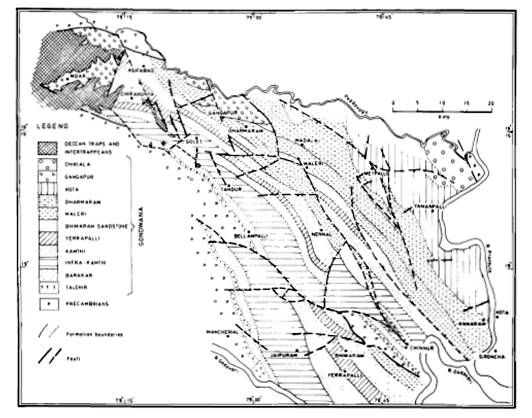Dharmaram Fm
Type Locality and Naming
Pranhita-Godavari Basin: Named after the village Dharmaram in Godavari Valley by Kutty (1969). The Dharmaram Formation is separated partly from the upper part of Maleri Fm beds and partly from the basal part of Kota Fm beds of King (1881). [Original Publication: King, W. 1981. The geology of the Pranhita-Godavari Valley. Mem Geol Surv India 18 (3), 1–161; Kutty, T. S. 1969. Some contributions to the stratigraphy of the Upper Gondwana formations of the Pranhita–Godavari Valley, Central India. Journal of the Geological Society of India 10, 33–48.]
[Figure 1: Geological map of the northern Pranhita-Godavari valley between Pedda Vagu and Godavari River (after Kutty et al., 1987)]
Lithology and Thickness
Clayey sandstone. It is an alternation of sandstone and clay. The sandstone contains pockets of clay and the clay bands have lenses of sandstone. It has thick sandstone band at its base which forms low and flat ridges. The sandstone is current bedded, pale grey, buff or reddish colored, coarse-grained, gritty or pebbly and also rich in lime-pellets and clay galls at places. However, the lime-pellet rocks are less frequent as compared to the Maleri Fm. The clay is dominantly of red color (Kutty, 1969; Kutty et al., 1987).
Relationships and Distribution
Lower contact
Dharmaram Formation conformably overlies the Maleri Fm
Upper contact
Dharmaram Formation is unconformably overlain by the Kota Fm.
Regional extent
Pranhita-Godavari Basin: It extends in NW-SE direction for about 2 km northwest of Dharmaram to southeast of Krishnapur. Westwards, the succession is gradually cut out by younger beds until, near Gangapur, the formation is completely absent (Kutty, 1969).
GeoJSON
Fossils
Kutty and Sengupta (1989) recognized two temporally successive vertebrate faunal zones within the Dharmaram Formation. The Lower Dharmaram faunal zone yielded pisces: Arganodus (Ceratodus) nageswari (Shah and Satsangi 1969; Skrzycki et al., 2018), Mooreodontus indicus (Jain 1980; Kutty and Sengupta, 1989); chigutisaurid amphibians: Compsocerops cosgriffi, Kuttycephalus triangularis; diapsid reptiles: cf. Leptosuchus, Angistorhinus, Aetosauria indet., Nambalia roychowdhurii, Jaklapallisaurus asymmetrica (Novas et al., 2011), Guibasauridae indet., cf. Nicrosaurus, cf. Paratypothorax (Kutty and Sengupta, 1989), and synapsid reptile: cf. Ischigualastia. The vertebrate fauna of the Upper Dharmaram faunal zone comprises of reptiles: Lamplughsaura dharmaramensis, Pradhania gracilis, Theropoda indet. aff. Dilophosaurus (Wu & Chatterjee, 1993), Sphenosuchidae indet. aff. Dibothrosuchus (Kutty et al., 2007).
Age
Depositional setting
The Dharmaram Formation deposits are interpreted to be fluvial deposits.
Additional Information
References
Bandyopadhyay, S., and Roy Chowdhury, T., 1996, Beginning of the continental Jurassic in India – a palaeontological approach. Museum of Northern Arizona, Bulletin, 60, 371–378. Feistmantel, O., 1879. Outliers on the Madras coast. In: The fossil flora of the Upper Gondwanas. Mem. Geol. Surv. India Palaeont. Indica, Ser. 2, 1, 1-34. King, W. 1981. The geology of the Pranhita-Godavari Valley. Mem Geol Surv India 18 (3), 1–161. Kutty, T.S. 1969. Some contributions to the stratigraphy of the Upper Gondwana formations of the Pranhita–Godavari Valley, Central India. Journal of the Geological Society of India 10, 33–48 Kutty, T. S., Chatterjee, S., Galton, P. M., and Upchurch, P. 2007. Basal sauropodomorphs (Dinosauria: Saurischia) from the Lower Jurassic of India: their anatomy and relationships. Journal of Paleontology, 81: 1552-1574. Kutty, S. and Sengupta, D. P. 1989. Late Triassic formations of the Pranhita-Godavari Valley and their vertebrate faunal sequence – a reappraisal. Indian Journal of Earth Sciences, 16: 189-206. Jain, S.L., 1980. Freshwater xenacanthid (=Pleuracanth) shark fossils from the Upper Triassic Maleri Formation, India. Journal of Geological Society of India 21, 39–47. Novas, F. E., Ezcurra, M. D., Chatterjee, S., and Kutty, T. S. 2011. New dinosaur species from the Upper Triassic Upper Maleri and Lower Dharmaram formations of Central India. Earth and Environmental Science, Transactions of the Royal Society of Edinburgh, 101: 333-349. Shah SC, Satsangi PP. 1969. A new Ceratodus species from the Maleri Beds, Andhra Pradesh. Rec Geol Surv India. 98:175–178. Skrzycki P, Niedźwiedzki G, Tałanda M. 2018. Dipnoan remains from the Lower-Middle Triassic of the Holy Cross Mountains and northeastern Poland, with remarks on dipnoan palaeobiogeography. Palaeogeogr Palaeoclimatol Palaeoecol. 496:332–345.
